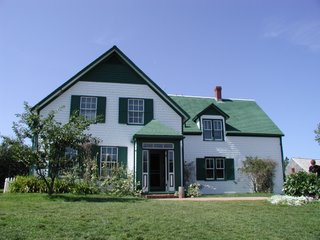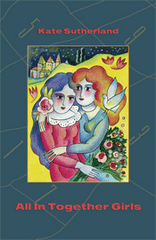
The house in the photo above is the one on which L.M. Montgomery modelled Green Gables, and I’m off to Prince Edward Island to have another look at it. Of course, there’s much more to PEI than its association with Montgomery and her creations. It’s the birthplace of at least one other literary giant: Milton Acorn, known throughout Canada as “the people’s poet.” Many talented contemporary Canadian writers make their home there, for example, J.J. Steinfeld. It’s even home to one of my favourite fictional poets, young Lawrence Campbell, narrator of Lynn Coady’s excellent novel Mean Boy. And outside the literary realm, there’s that whole cradle of Canadian confederation business.
However, Montgomery is the draw for me this time around. Over the next couple of days I’ll be attending a conference titled Storm and Dissonance: L.M. Montgomery and Conflict. I look forward to hearing presentations with such tantalizing titles as “The Darker Side of L.M. Montgomery,” and “Projecting Dissonance: The Real and Virtual Landscapes in Anne of Green Gables and Dracula.” And to making a presentation of my own which marks a bit of a departure in my academic work.
Time and internet access permitting, I’ll check in with occasional bulletins from the conference. In the meantime, I’ll leave you with an entry from Montgomery’s journals, dated February 1922, to whet your appetite. This is hardly scandalous, but perhaps not what you expected from the author of Anne of Green Gables:
[Captain Smith] was here both Saturday and Sunday nights and we spent both evenings talking of a thousand subjects. It is such a delight to have a real conversation with a companion of intellect and sympathy. Captain Smith is one of the few people I have met with whom I can discuss with absolute frankness, any and every subject, even the delicate ones of sex. Sex is to men and women one of the most vital subjects in the world—perhaps the most vital subject since our total existence is based on and centres around it. Yet with how few, even of women, can this vital subject be frankly and intelligently discussed. It is so overlaid with conventions, inhibitions and taboos that it is almost impossible for anyone to see it as it really is.
(From The Selected Journals of L.M. Montgomery, Volume III: 1921-1929.)

7 comments:
Have a great time at the conference! It's a very odd mix of folks--rabid fans and scholars. Can't wait to hear tales of PEI
I was so interested to hear the history of the house. All those writers! What a wonderful subject for a novel it would make!
What a beautiful house. And who'd have thought L.M. had a dark side? Sounds like Captain Smith gave her some scope for the imagination. ;-)
Wow, so jealous! I'm dying to see PEI, and the hometown of my favorite childhood fictional characters. Love the diary excerpts: I thought I'd read all of Montgomery's writings, suppose it's good that I overlooked that portion when I was 12.
litlove,
The literary connections that I outlined were for Prince Edward Island as a whole, not the house alas. Even Montgomery herself never lived there. It was owned by her cousins. But it would have been quite something to have the walls of one house soak up all that creative energy! For a book along those lines, see Sheryl Tippins' fabulous February House which tells the story of a house in Brooklyn which served as communal living space in the early 1940s for an extraordinary crowd of writers and musicians including Carson McCullers, W.H. Auden, George Davis, Gypsy Rose Lee, Benjamin Britten, and Jane and Paul Bowles.
Well, thank you! I'll most certainly look that up.
I adored the Anne books as a child and re-read the entire series a few years ago. I once thought I would like to visit PEI but now I think it is better that I keep my own visualisation of Anne's domain.
By the way, my favourite Anne books are probably Anne of the Island and Rilla of Ingleside. The latter is a poignant WWI tale.
Post a Comment